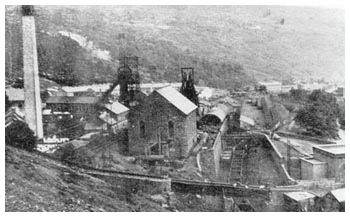
| Wattstown | |
Wattstown is one of the smaller villages within the Rhondda and prior to industrialisation was known as Pont Rhyd Y Cwch, or alternatively Pont-Y-Cwtch, and is still known today by its residents as ‘Cwtch'. Even with the beginning of industrialisation within the Rhondda Fach, the area was seen very much as somewhere to pass through on the way from Porth to the settlements of Tylorstown, Ferndale and Maerdy. Its development as a village began with the sinking of the National Colliery in the early 1880's. In 1881 two shafts were sunk on land leased from Crawshay Bailey and William Partridge Bailey by three coal owners Ebenezer Lewis, Henry Lewis and Mathhew Cope. The National Collieries were worked by a number of different concerns, including Messrs. Griffiths and Company, and Watts, Watts and Company, after whom the village eventually became named. |
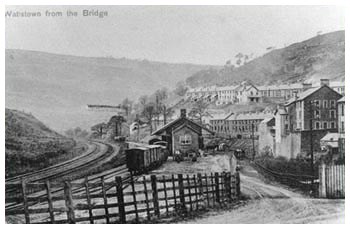 |
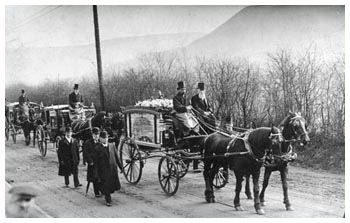 |
The National Colliery during its lifetime suffered two major disasters, the first in 1887 where 39 men and boys perished. The second disaster occurred in July 1905 and killed a total of 119 workers, a loss of life that completely devastated the small close-knit community. After the first of these disasters the colliery was sold to the National Steam Coal Company Limited, later known as the National Collieries Company Limited. Eventually becoming part of the Ocean Coal Company combine pre-nationalisation. The colliery was eventually closed in November 1968. |
Above and Right: The funeral of the victims of the Wattstown (National Colliery) Pit Disaster, July 1905 - The cortege was reported to extend for five miles, as the head of the procession was turning into Llethr Ddu Cemetery, Trealaw, the last were about to leave Wattstown With the sinking of the colliery in Wattstown and its subsequent development as a village ED Lewis, in his book ‘The Rhondda Valleys', describes how the Rhondda Fach had changed so that; ‘The face of the countryside was transformed and the urban ribbon of houses in the Rhondda Fach was to stretch from Ynyshir to Maerdy'. |
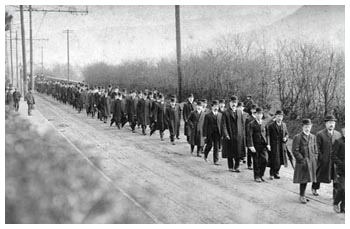 |
National Colliery Circa 1920 |
Despite the presence of the colliery, and the workers it brought to the area Wattstown never developed to the extent of other villages in the Rhondda Fach. Although it had its own church, St. Thomas built in 1896, public houses, school, chapels etc. it was never to grow to the extent of many of its neighbouring villages. This is clearly shown in the 1906 Kelly's Industrial Directory for the area whereby only four private residents are listed, a curate, a surgeon, a Baptist minister, and the resident of Glenside House (built originally by Henry Lewis the supervisor of the sinking of the colliery), this was at the time when even the village of Ystrad itself a small village had 27 listed private residents. Similarly the commercial listing contains all the necessities of life in terms of butchers, bakers etc. but to much lesser extent than other villages in the locality. |
NATIONAL COLLIERY WATTSTOWN EXPLOSION 18TH FEBRUARY 1887 |
|
| Wattstown's (though the town hadn't been named as such at that time, being alternately called Ynyshir or Cwtch) first major mining disaster is described in the Rhondda Chronicle newspaper of the 25th February, Between twenty minutes and a quarter to seven o'clock on Friday evening an explosion occurred at the National Colliery (Cwtch)'. Luckily at the time of the explosion the 200 men of the night shift had yet to descend the pit and the majority of the day shift had ascended, otherwise the death toll could have been a lot higher. The paper describes how ‘a loud retort was heard-the loudest and most fearful of the kind they (the workmen at the surface) have ever heard'. The explosion damaged the pit top and winding gear delaying the rescue efforts so that the first rescuers were unable to descend until three to four hours later. Almost immediately at the pithead thousands of people from the ‘populous neighbourhood' surrounding the colliery gathered to hear news of the men trapped underground. Upon descending, the rescuers were able to send to the surface, ‘almost immediately', twenty-nine uninjured and nine injured survivors of the explosion followed by six bodies. The newspaper describes the ‘most marvellous' escape, that of Samuel Strange employed as an ostler at the mine, who was discovered burnt but alive,' while all around him were 23 horses and three men all dead'. | 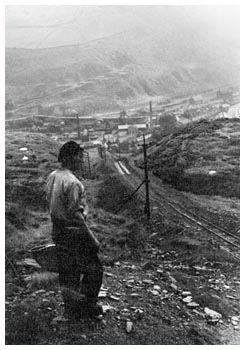 |
The eventual death toll of the explosion was thirty-nine men and boys, with a further six severely injured. An inquest jury sitting in the March following explosion returned the following verdict; However he is critical of the management of the mine on a number of points, particularly the lack of an efficient means of watering the mine and removing dust which ‘abounded in the mine'. He also criticises the lax monitoring of the use of lamps and explosives in the mine. The actual cause of the explosion he believed was due to a shot fired in the Cwm Nedd district of the mine. He believed the evidence was clear as to this being the origins of the explosion, he reports that on the very day of the explosion John Jones reported gas in his stall ‘worse than he had ever known it before'. There was such an accumulation of gas that it was sufficient to produce a ‘cap' in a safety lamp some thirty-three yards away at the junction of the stall road with the Risca heading. It was in this area that he believed evidence pointed to a shot having been fired at the time of the explosion. In his report Mr. Bosanquet believed that the firing of the shot whilst the ‘ eight-hour' shift were in the mine clearly infringed the Coal Mines Regulations Acts of 1872 and he recommended that ‘proceedings should be taken against Mr.Watts, the agent and Mr.Williams the manager, for this breach of the rules'. |
|
| THE NATIONAL COLLIERY WATTSTOWN DISASTER TUESDAY 11TH JULY 1905 | |
| ‘Calamity at Wattstown-Immense loss of life- Heartrending scenes' are how the headlines of the Rhondda Leader newspaper of the 15th July described the explosion at Wattstown Colliery that claimed the lives of 120 men and boys. The following week the newspaper called it ‘The Wattstown Holocaust.' The report goes on to say how, ‘For the second time during the present year the Rhondda Valley has been visited by one of those great calamities which has made its name synonymous with death and unexampled bravery'. For it was only four months previously that an explosion had killed 32 miners at the Cambrian Colliery in Clydach Vale. This disaster in the words of the reporter of the time, ‘adds another to the already long list of gruesome and terrible disasters', that had befallen the miners of the Rhondda. It states how at ‘about 12 O'clock on Tuesday a volume of debris shot out of the pit's mouth, accompanied by an ominous thud and a low rumbling as of distant thunder.' By three o'clock thousands had gathered at the pithead and the police had to form a cordon around the colliery yard. The bodies as they were recovered were laid out at a temporary mortuary at the blacksmiths shop for identification, however the extent of the injuries suffered meant many were only identified through personal possession, scraps of clothing etc. | |
| The explosion occurred in the nine-foot seam where normally 150 to 200 men worked, however on the day of the explosion a number of men were not in work otherwise the death toll would almost certainly been higher. Three men were rescued alive from the seam after the explosion however two of these, John Dando and John Reeves, subsequently died of their injuries leaving Matthew Davies as the only survivor.The Reports into the disaster by E.Milner Jones, barrister at law, and the Inspectors of Mines F.A. Gray and J.T. Robson concurred as to the cause of the explosion. They believed that the manager had decided to blast through a barrier of coal to drain an accumulation of water and sludge into the sinking pit. The original plan being to bring the water up through the upcast shaft at night which would have been time consuming and disruptive to the operation of the mine. This supposition was supported by the fact the master sinker had asked for blasting cable shortly before the explosion, and a battery used for shot firing was also taken below ground. Additionally the manager, Mr.Meredith had descended the pit only fifteen minutes prior to the explosion, and the bodies of the manager and the sinkers were found at the bottom of the sinking pit. Crucially when the water and rubbish had been finally removed from the heading after the explosion the barrier of coal had ‘completely disappeared. The conclusion of these reports was critical of the management of the mine in a number of areas. In particular it berated the management for ‘lax discipline' in the use of explosives in the mine and for shot-firing during shifts, and the system of watering the mine. E.Milner Jones actually states that, ‘The evidence given at the inquest discloses a lax of discipline and a total disregard of specific statutory rules for the use of explosives in mines' and added that he would not recommend prosecution as the manager of the mine had himself died in the explosion. |
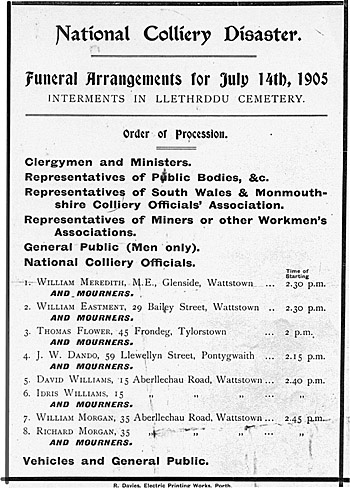 |
After the explosion messages of sympathy from throughout Britain were received at Wattstown, the King himself sent a message which read: ‘The King is anxious to express to you personally, to the widows, the orphans, and other relations of those who have lost their lives in the recent colliery accident, the profound sympathy he and the Queen entertain for them on the overwhelming calamity which has befallen them. Their majesties feel most sincerely and deeply for them in their great sorrow.' |
|
